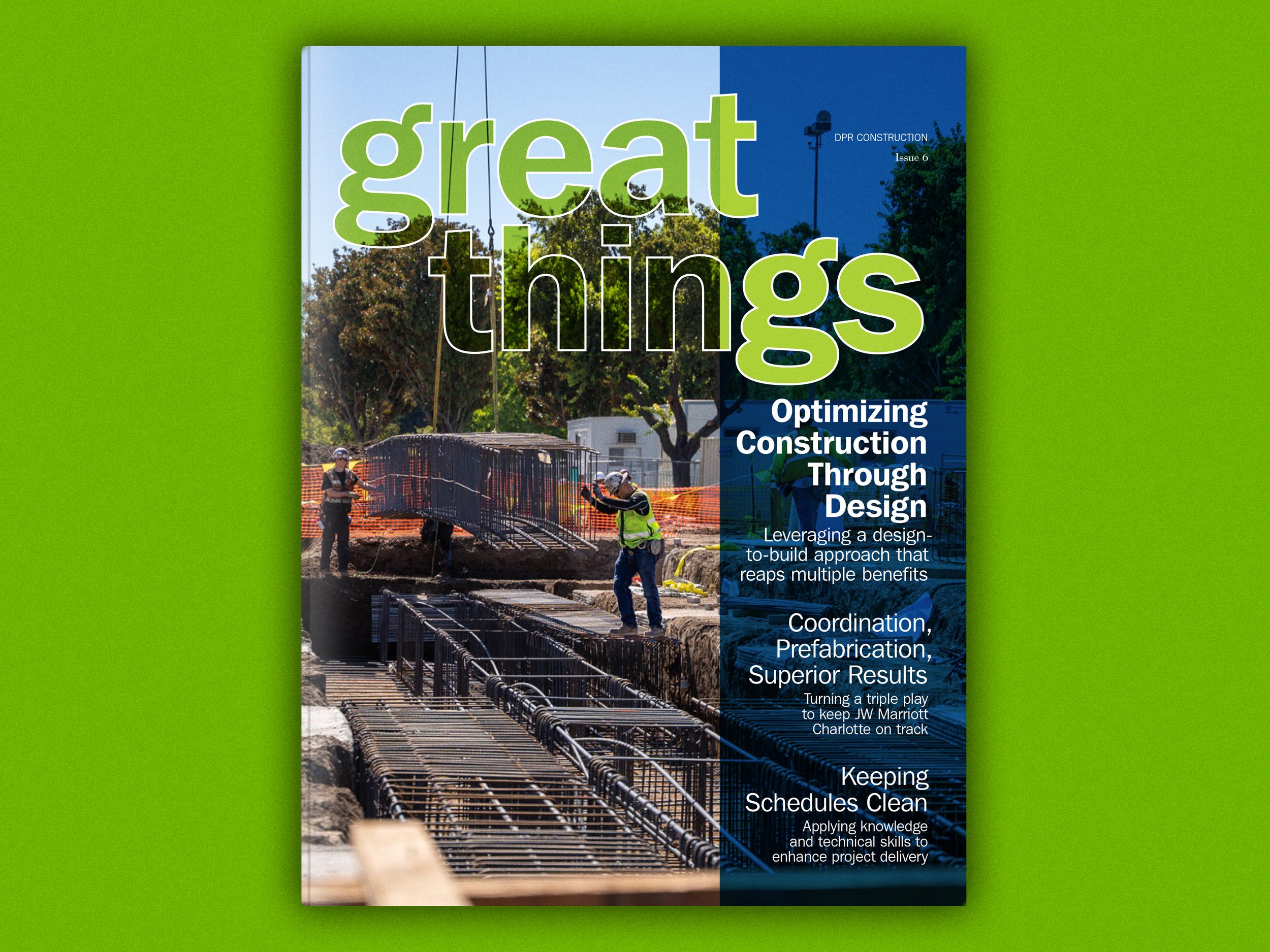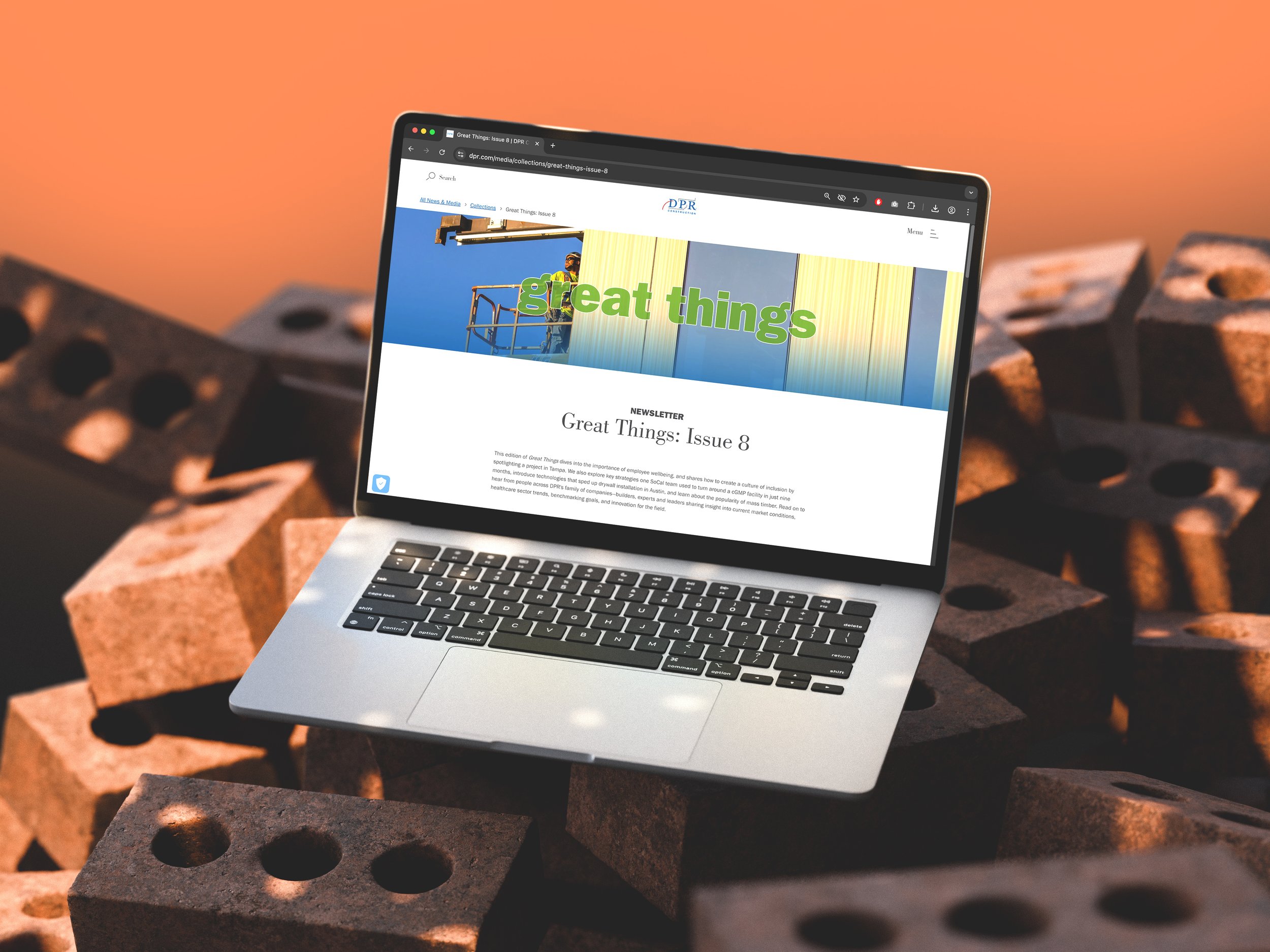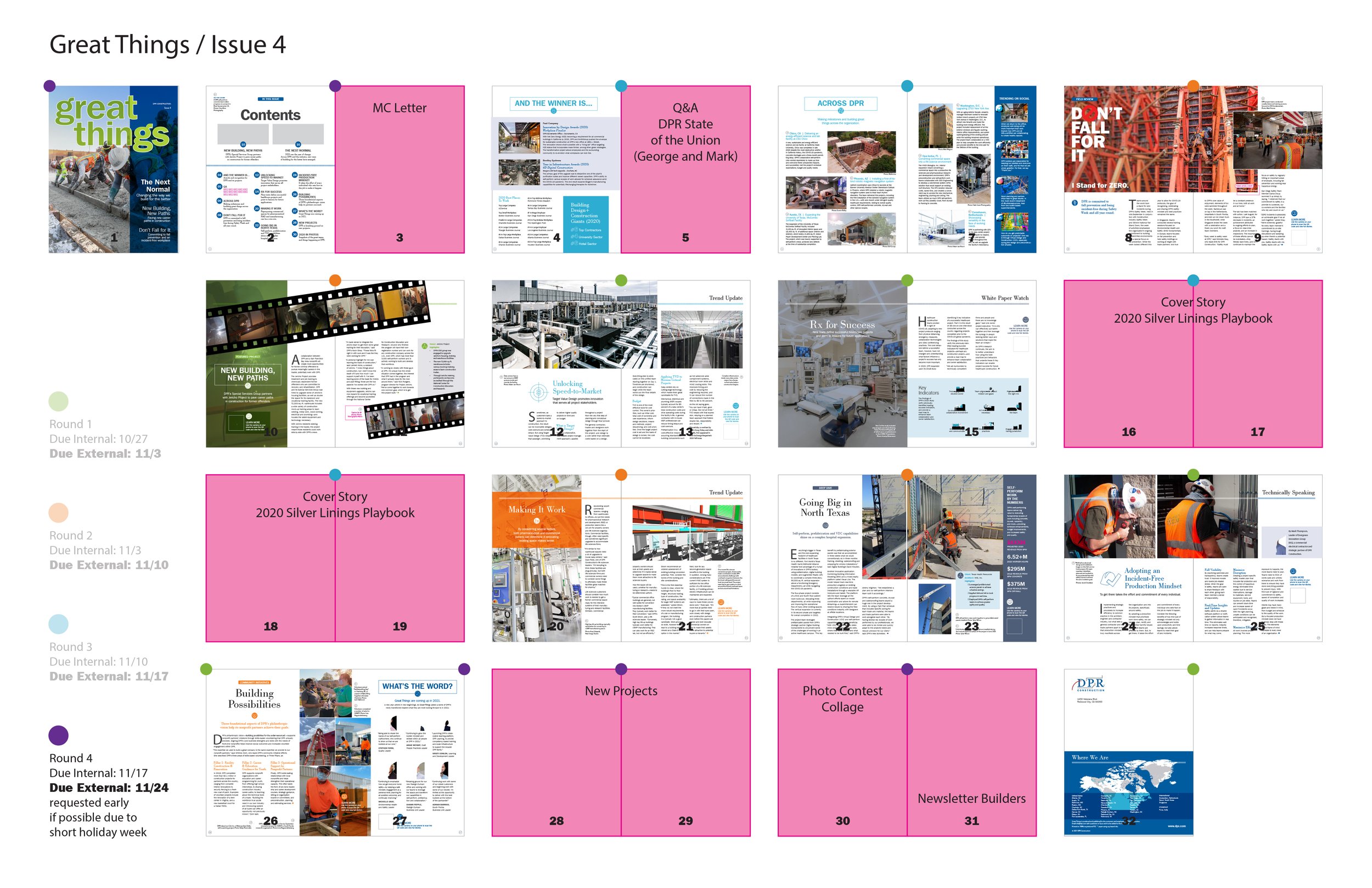GREAT THINGS
Optimizing print and digital production of a trade publication.
Role: Creative Director
Collection view and cover for issue 8
Process improvements across all channels for a semiannual publication.
SERVICES
Agency relationship management, creative direction, project management, web design, content modeling, UI, UX, print design.
CIRCULATION
10,000 printed editions produced for each edition
20,000 digital content impressions
ON THE WEB
TECHNOLOGY AND TOOLS
Slack - project communication with agency partners
Teams - internal communication
Jira - project management and issue tracking with agency partners
Trello - project epics and story organization
Craft CMS - custom tagging and behaviors for website content
Monday - project management platform
Word - requirements documentation
PowerPoint - flat plan
InDesign - print template and production layout
Illustrator - supplemental iconography and technical illustration
Photoshop - asset production and image color correction
Adobe XD - website design, prototyping and collaboration
Adobe Acrobat - review comments
Press Check - loose color proof and advance copy for print run approvals
Box - stock photo library, photo tagging and safety review coordination
Bitly - scan data for URL shortener and QR codes
PROJECT DETAILS
About Great Things
Great Things is a semiannual publication, produced by DPR Construction, with a printed circulation of approximately 10,000 copies and digital visits reaching 20,000 combined impressions. It is focused on major projects, cultural stories and innovations in construction across the company.
This owned media aims to connect with employees, equipment suppliers, trade partners, and project owners in a celebratory way; being strategically targeted at retaining employees and continuing to win more work through existing relationships.
THE ASK
The communications lead approached me with a request to help improve the production design process while reducing the cost to create an edition. At that time, it was taking 8-10 months to produce a single edition with significant friction and overage charges. There was a very real risk of losing the production agency relationship.
Improve the production process and reduce the cost to create an edition.
The newsletter editor and communications lead understood that they needed to create a replicable edition cycle, release a printed and digital edition at the same time, and address a ballooning budget while continuing to deliver publications in a timely manner.
The results of my audit and process improvements strengthened our agency relationships while reducing the time and production labor cost of an edition by half—this success was replicated on subsequent editions.

GETTING ORGANIZED
Create a more efficient and predictable publication cadence.
The primary tasks were to: analyze the production process; address ballooning costs and agency relationship friction; and align the print and digital production schedules.
I met with the internal teams and supporting agencies to gather feedback and catalog issues in the overall project effort. The stakeholders supported tackling a list of key findings I identified to improve the biggest points of friction.
Together, we created success through project management software, templates, planning tools and collaboration focused on incorporating continuous improvements.
Diagrams of activity and role complexity helped show why a more measured approach was needed to succeed (illustrative example).
Key Findings and Solutions
Vaguely defined responsibilities were causing conflict and a lack of accountability.
Created an edition template in our project management software, Monday, where each person had a clear role and activities they were responsible for.
Opened the status of activities to everyone on the team, creating a system of accountability that quickly identified areas of an edition that were at risk of slippage.
Decisions that had previously been sidelined in email threads or direct messages were captured during a weekly edition leadership meeting and entered in the platform to maintain alignment.
Inconsistent planning was impeding decision making and risk mitigation.
Introduced a flat plan to the Editor's story development process. The flat plan opened up new opportunities for collaboration with photographers while also enabling spread swapping before engaging design agency resources. This coordination easily saved three to six rounds worth of revisions to have a senior designer move pages around.
Created a process to identify spreads and images at risk of being denied final approval, enabling the creation of backup stories that would either slide in as replacements or carry forward to the next issue ready to go. These backup stories became invaluable as the print production length was driven by a page count and a pre-ordered stock of paper.
Developed stories for print and their long-form digital versions at the same time. The website collections were scheduled to release in tandem with the mail drops and marketing activities without any additional website support needed. This reduced schedule and coordination risks and brought schedule ownership internally.
Design revisions—in excess of twenty rounds per edition—were resulting in overage charges to meet production deadlines.
Directed the creation of a base template system that authors must pick from to reduce one-off designs. This removed the unknown amount of layout designs bogging down the initial draft phase. Any custom spreads were already identified and budgeted for during edition planning prior to handoff for initial production layout.
Identified word counts for headlines and supporting copy to divorce the visual layout from the copywriting and approval phases, again reducing back and forth and considerable delays waiting to see if things would fit in a layout.
Introduced process planning to develop content and secure approvals separately from laying out an issue. This resulted in edits and revisions being very minor in the production phase, which significantly improved the entire production process.
Reduced conflicts by removing excess people from meetings and email threads, instead assigning a single point of contact to collect all edits and deliver them as a concise and complete round of feedback.
Flatplan with basic information
Flatplan with risks identified
Outcomes
The process improvements bolstered team morale. With clear roles and responsibilities tracked in project management software, each person was able to take ownership and feel empowered to guide their contributions to completion. This accountability also brought clarity to schedule risks and created opportunities for collaborative problem solving.
Utilizing a project cycle template, the edition cadence became predictable. This brought publication back on schedule, while improving our agency relationships and slashing the production cost by more than half.
Introducing synchronized planning and workflows—instead of serialized—to the print and digital editions, enabled predictable coordination of the print production and web launch, increasing marketing opportunities and distribution reach.
CONTINUOUS PROCESS IMPROVEMENTS
Opportunities for further improvement were identified by conducting a retrospective. We discussed the template, flat plan, and project planning impacts on the process. We collected what went well, what still needs improvement, budget impacts, how the team feels and suggestions for the following edition.
These key opportunities were slotted into the next edition, establishing a cycle of built-in improvements tackled alongside active content development.




CREATING AN EDITION
Lead the design process in collaboration with the Editor.
Along with the implementation of process improvements, a base template was created with our production design agency. Leveraging the template and flat plan—developed during process improvements—the Editor and I coordinated the stories in an edition, identifying areas of opportunity and risk.
The template consisted of a number of fixed pages for recurring content, as well as designed spreads that could be swapped in and out or combined with one another to create a layout supporting a wide range of content.
Feedback about past edition layouts was collected and used to develop a core template.
The base template consisted of pages that could be easily referenced and swapped to build an edition.
Parallel Processes
Stories for print as well as their long-form digital versions were taken through the development process at the same time, this allowed all of the copy, photography, videos and illustrations to be reviewed and approved independent of one another.
Printed stories are heavily edited for length.
The entire story is presented on the web, along with photos and videos.
Printing and Promotion
Our printing partner coordinated the loose color proof, printing proof and final mail drop print runs. Editions are printed on recycled paper with biodegradable inks.
We generated QR codes linking printed stories to supporting digital materials—capturing data points from print about what people were reading and what content they wanted more information about.
Email campaigns, social posts and web promotions were coordinated to go live on the same day printed editions arrived in mailboxes.
The audience skews towards ages 40+ with email being the most successful promotional channel. We aimed to tailor emails to better engage with this segment.
An example of an A/B test we ran through Mailchimp.
Click map analysis was assembled to present results and recommendations to team leads.
Outcomes
The combination of process improvements and deeper design involvement in the planning phase created clear expectations and production schedules. This brought the release cadence into six months or less per edition.
The following editions required less heavy design direction, as our agency design partners were able to execute the visual layout based on the template and clear expectations. This allowed more time to teach team members how to run an edition.

DIGITAL COLLECTIONS
Content modeling and design to display an edition in a curated digital format.
We met with our development agency to understand existing CMS features and identify custom needs to quickly collect and display content as a collection. The development team created new relationship fields in the CMS, allowing the digital publishing team to stage content and apply an association to display it where it needed to go automatically on a set date.
Where previously someone had to enter the website version of articles upon completion of the printed magazine, now both the digital and printed editions could be developed and approved simultaneously. The dynamic relationships allowed a piece of content to exist in a singular location in the CMS, and displayed and referenced in a multitude of ways to a website visitor.
No additional work was required to publish a story to appear in the blog feed and as a digital newsletter—where previously those pieces of content existed separately as duplicates.
A collection was designed as a view of the media feed, consisting of existing entry types. Leveraging components in production, only a few new visual elements were needed to create the collection experience. The primary lift was CMS feature development.
An entry referenced from the main feed and a collection. Each entry in a collection received an automatic link to the collection listing page.
Outcomes
Collections improved the publishing flow, reducing mistakes caused by duplicated entries. This was achieved by implementing a dynamically generated view of content that could be built with a few tags within the CMS.
The digital edition is available to the general public and referenced in printed material for the long-form version of content—consisting of additional copy, photography and videos.
The digital edition averages 20,000 impressions in the first week of launch and promotions.

RESULTS
Cut the cost to produce an edition by half.
Revitalized and strengthened our agency partnerships, creating a more positive and collaborative experience.
Increased circulation and digital impressions with targeted promotions, email campaigns and reliable releases.










